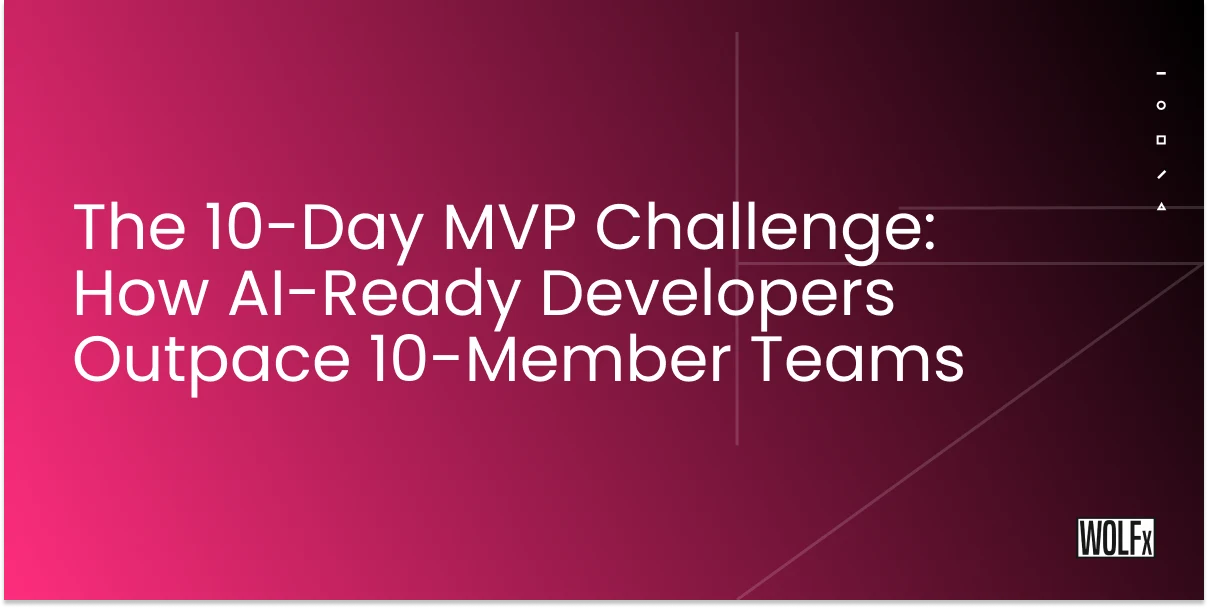In today's fast-paced tech landscape, startups and enterprises alike are racing to launch their products faster than ever before. The emergence of AI-ready developers has revolutionized the way software is built, enabling teams to develop Minimum Viable Products (MVPs) in record time. One of the most exciting concepts that have gained traction is the 10-Day MVP Challenge, where development cycles are cut drastically, allowing businesses to validate ideas, get feedback, and iterate rapidly.
This blog explores how AI-assisted coding is accelerating MVP development, enabling smaller teams to outpace traditional 10-member development teams while significantly reducing costs and time to market.
What Is the 10-Day MVP Challenge?
The 10-Day MVP Challenge is a lean approach to developing an MVP within 10 days, using AI tools, rapid prototyping, and automation. The goal is to quickly validate an idea with minimal resources and deliver a functional product that can be tested with real users.
For tech companies, this challenge is not just about speed but also about smart, AI-powered software development. By leveraging AI coding assistants, low-code AI tools, and AI pair programming, teams can reduce development time by as much as 70%, a feat that would have been unthinkable just a few years ago.
Why 10 Days? Why Not 3 Months?
In traditional software development, building an MVP could take months. However, with AI, what once required a large development team comprising frontend, backend, QA engineers, and project managers can now be streamlined into a small, lean team of 1–2 developers.
By relying on AI tools that handle repetitive tasks (e.g., code generation, testing, bug fixing), developers can focus on more critical aspects like architecture, design, and product strategy. Rapid prototyping tools powered by AI ensure that the design and development process is as efficient as possible.
How AI-Assisted Coding is Changing the Game
The power of AI-assisted coding cannot be overstated. Tools like GitHub Copilot, LangChain, and OpenAI’s Codex are empowering developers to code faster by predicting and auto-completing chunks of code based on context. This drastically reduces the time spent writing boilerplate code and helps AI-driven app development teams produce working features almost instantly.
Key Benefits of AI-Driven Development:
1. Code Generation: AI tools can generate the core framework of an MVP within hours, including APIs, basic functionality, and integrations.
2. Bug Detection & Fixing: AI can continuously monitor and automatically fix bugs, reducing the need for extensive QA teams.
3. Architecture Planning: AI can recommend the best architecture based on the project’s requirements, saving time on backend setup.
4. Scalability & Maintenance: With AI software engineering, scalable solutions are built from day one, ensuring that the MVP can grow as the business scales.
This combination of automation, AI-powered prototyping, and agile AI workflows leads to faster MVP launches, enabling companies to stay ahead of the competition.
The Traditional 10-Member Team vs. 2 AI-Ready Developers
Typically, a 10-member team in a traditional startup would include developers (both frontend and backend), QA engineers, project managers, and designers. While this team structure works well for larger, more complex projects, it can be slow and expensive when the goal is to build and launch a MVP fast.
Downsides of Traditional Development Teams:
1. Communication Gaps: More people mean more chances for miscommunication and delays.
2. Slower Iteration: Coordination between multiple team members slows down the process of feedback and iteration.
3. Higher Costs: More developers and higher overhead costs.
AI-Ready Developer Teams:
On the other hand, with AI-powered software development, teams can shrink to 2–3 developers who rely heavily on AI tools to handle the heavy lifting. AI is leveraged primarily for repetitive tasks, like writing basic code, setting up infrastructure, and running initial tests. This allows developers to focus on the aspects of the project that truly require human expertise, such as user experience, performance optimization, and business strategy.
In short, small teams armed with AI tools can perform just as efficiently, if not better, than larger teams when it comes to building an MVP in record time.
The AI-Driven MVP Framework
A typical AI MVP framework could look like this:
Day 1: Requirement Mapping & Architecture
Define project requirements and goals.
Use AI tools to generate architecture and choose the appropriate technology stack.
Day 2-3: UI/UX Design
Leverage AI-driven design tools to quickly create wireframes and user flows.
Incorporate AI feedback to ensure the user experience is optimized for the target audience.
Day 4-6: Backend & API Generation
Use AI-powered tools to auto-generate the backend, including database schema, APIs, and authentication mechanisms.
Day 7-8: Frontend Integration
AI tools help generate the frontend code, connect APIs, and integrate with external systems.
Day 9: Testing & Refinement
AI assists in auto-generating test cases, running regression tests, and detecting bugs.
Day 10: Launch & Feedback
Launch the MVP, collect user feedback, and iterate on the product using AI-driven insights.
This framework dramatically reduces the time spent on manual tasks and enhances the overall startup product launch process.
Case Study: Lean AI Teams vs. 10-Member Teams
One of the most powerful ways to see the benefits of lean tech teams and AI-powered prototyping is through real-world case studies.
Example: Startup A vs. Startup B
Startup A (AI-assisted, 2 developers): Launched their MVP in 10 days with AI tools. It featured core functionalities, was well-received by users, and is already being iterated upon.
Startup B (Traditional, 10 developers): Took 3 months to launch an MVP with similar features. Due to delays, they lost early feedback and market relevance.
This MVP success story clearly shows how lean startup development with AI-driven app development outperforms traditional methods.
Why AI-Ready Developers Are the Future of MVP Development
AI-native workflows are the future of product acceleration with AI. As startups strive to build SaaS with AI, they increasingly prefer smaller teams that combine the power of human expertise and AI automation. In fact, 2025 and beyond will likely see an explosion of AI product development teams that can handle complex software projects with minimal human intervention.
AI will not replace developers; instead, it will augment human creativity, allowing them to focus on solving problems while the AI handles the tedious tasks.
Launch Your MVP in 10 Days
By leveraging AI-driven app development, AI-assisted coding, and lean tech teams, you can dramatically reduce the time and cost of launching your MVP. The 10-Day MVP Challenge is not just a time-saving tactic; it’s a strategic move that helps startups validate their ideas, get customer feedback, and iterate faster than ever before.
Whether you’re a tech startup or a large enterprise, this AI MVP framework will transform your development process and give you the competitive edge you need in today’s fast-moving market.
Start your 10-day MVP challenge today, and let AI-ready developers help you launch your product faster than ever before.

